Effective Recruitment and Selection Process for Small Businesses
VerifiedAdded on 2020/10/04
|11
|2942
|110
AI Summary
This assignment provides insights into the crucial role of effective recruitment and selection processes in small businesses. By employing the right person for the job, managers can reduce turnover and ensure that employees have the necessary skills to excel in their roles. The interview process allows companies to express their vision, goals, and needs while also providing opportunities for applicants to showcase their qualifications. A well-structured recruitment and selection process is vital for small businesses looking to grow and succeed.
Contribute Materials
Your contribution can guide someone’s learning journey. Share your
documents today.
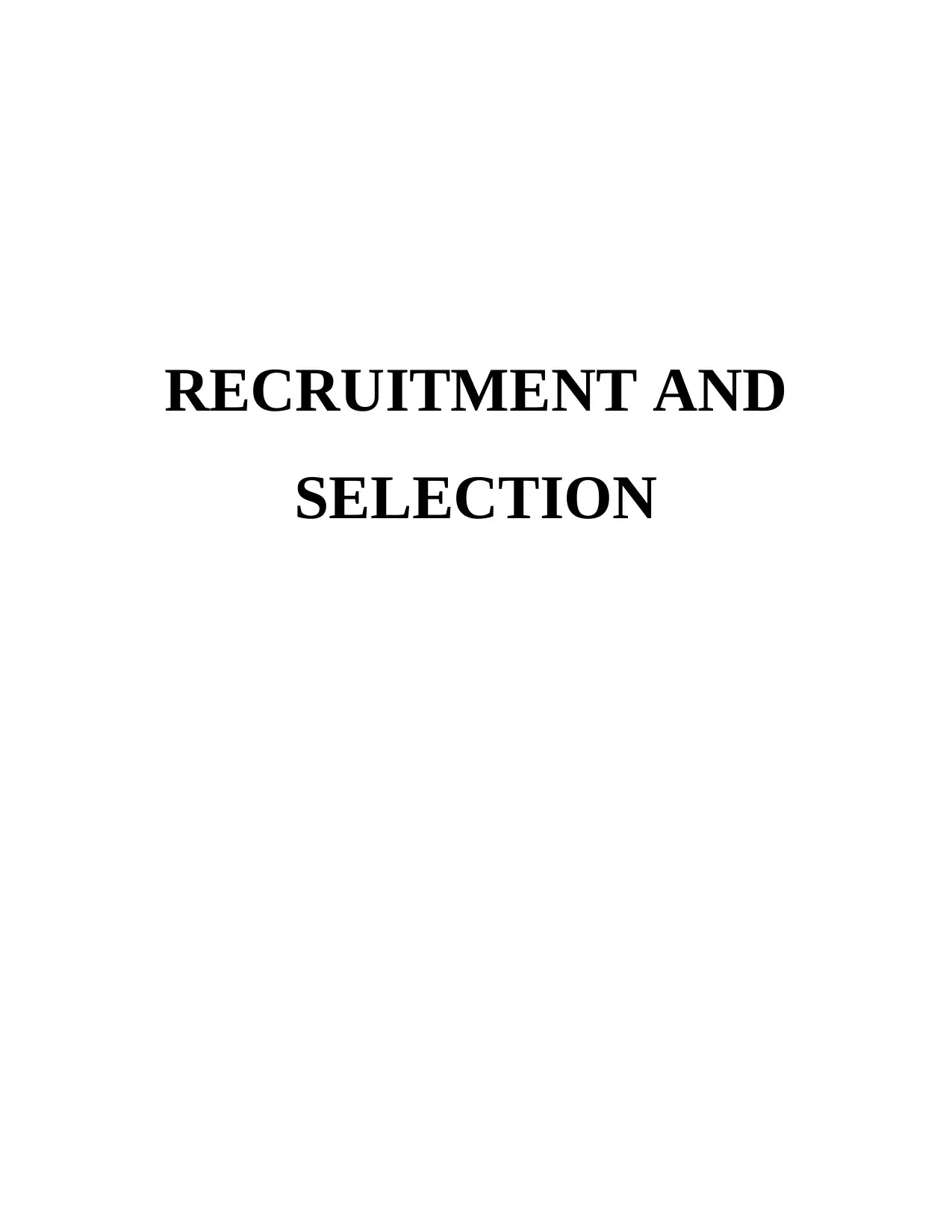
RECRUITMENT AND
SELECTION
SELECTION
Secure Best Marks with AI Grader
Need help grading? Try our AI Grader for instant feedback on your assignments.
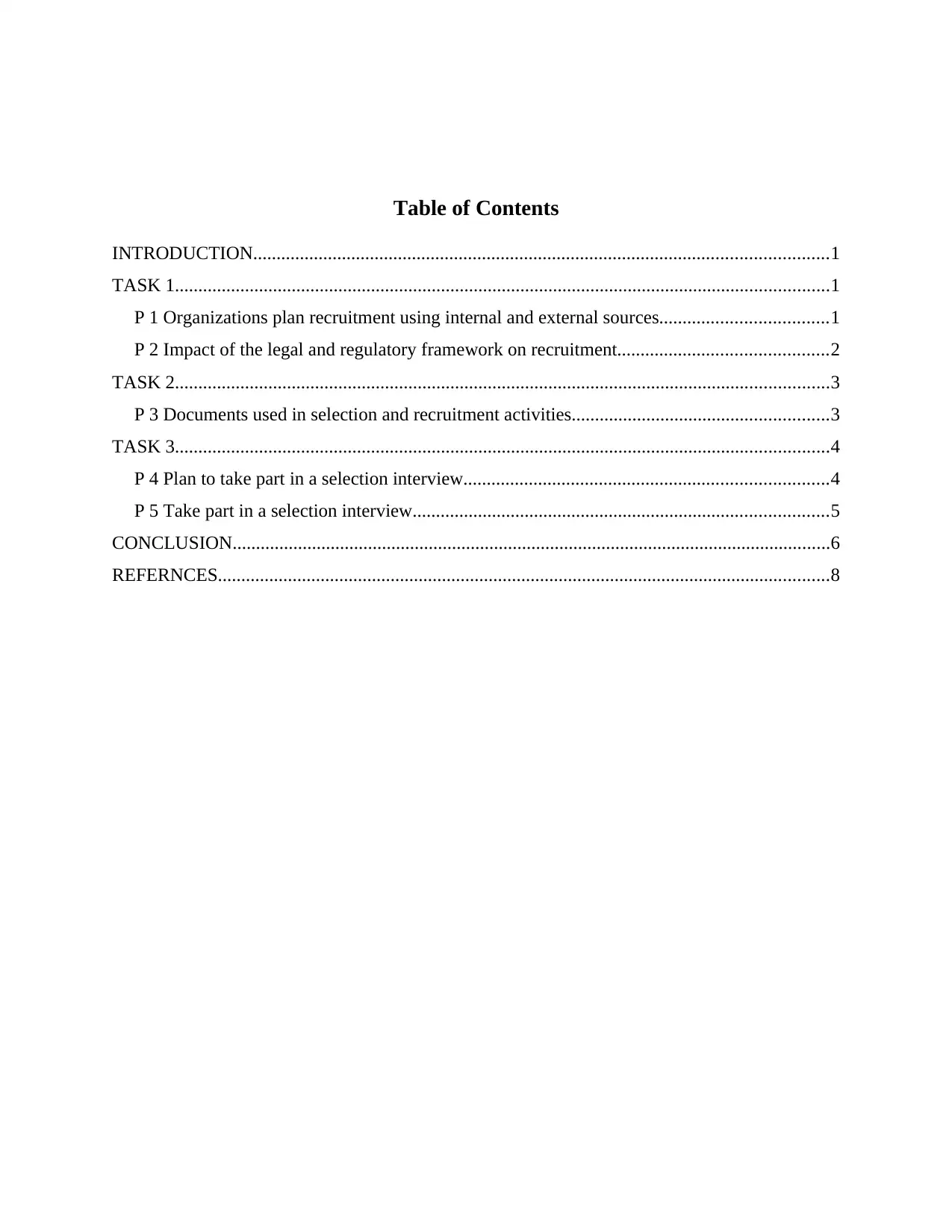
Table of Contents
INTRODUCTION...........................................................................................................................1
TASK 1............................................................................................................................................1
P 1 Organizations plan recruitment using internal and external sources....................................1
P 2 Impact of the legal and regulatory framework on recruitment.............................................2
TASK 2............................................................................................................................................3
P 3 Documents used in selection and recruitment activities.......................................................3
TASK 3............................................................................................................................................4
P 4 Plan to take part in a selection interview..............................................................................4
P 5 Take part in a selection interview.........................................................................................5
CONCLUSION................................................................................................................................6
REFERNCES...................................................................................................................................8
INTRODUCTION...........................................................................................................................1
TASK 1............................................................................................................................................1
P 1 Organizations plan recruitment using internal and external sources....................................1
P 2 Impact of the legal and regulatory framework on recruitment.............................................2
TASK 2............................................................................................................................................3
P 3 Documents used in selection and recruitment activities.......................................................3
TASK 3............................................................................................................................................4
P 4 Plan to take part in a selection interview..............................................................................4
P 5 Take part in a selection interview.........................................................................................5
CONCLUSION................................................................................................................................6
REFERNCES...................................................................................................................................8

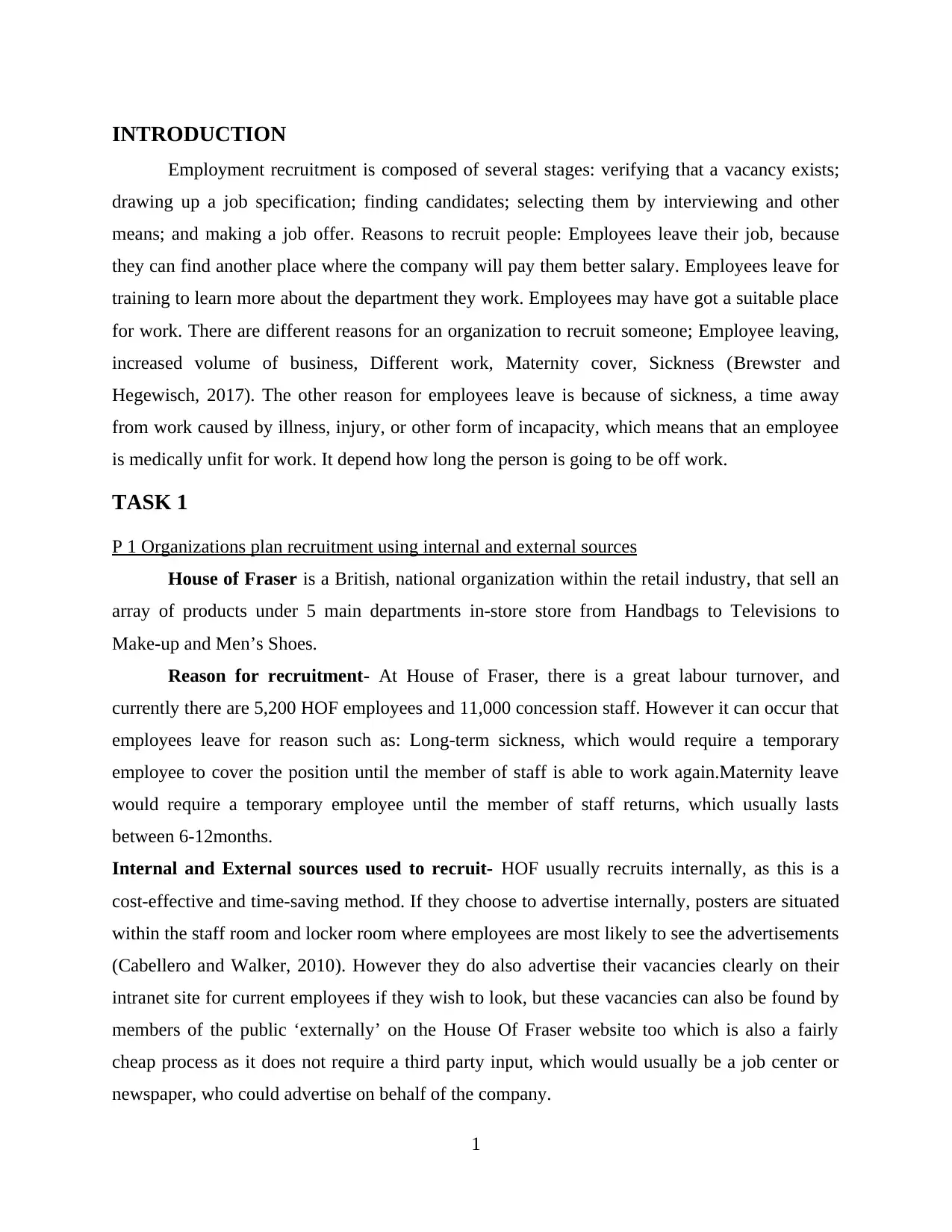
INTRODUCTION
Employment recruitment is composed of several stages: verifying that a vacancy exists;
drawing up a job specification; finding candidates; selecting them by interviewing and other
means; and making a job offer. Reasons to recruit people: Employees leave their job, because
they can find another place where the company will pay them better salary. Employees leave for
training to learn more about the department they work. Employees may have got a suitable place
for work. There are different reasons for an organization to recruit someone; Employee leaving,
increased volume of business, Different work, Maternity cover, Sickness (Brewster and
Hegewisch, 2017). The other reason for employees leave is because of sickness, a time away
from work caused by illness, injury, or other form of incapacity, which means that an employee
is medically unfit for work. It depend how long the person is going to be off work.
TASK 1
P 1 Organizations plan recruitment using internal and external sources
House of Fraser is a British, national organization within the retail industry, that sell an
array of products under 5 main departments in-store store from Handbags to Televisions to
Make-up and Men’s Shoes.
Reason for recruitment- At House of Fraser, there is a great labour turnover, and
currently there are 5,200 HOF employees and 11,000 concession staff. However it can occur that
employees leave for reason such as: Long-term sickness, which would require a temporary
employee to cover the position until the member of staff is able to work again.Maternity leave
would require a temporary employee until the member of staff returns, which usually lasts
between 6-12months.
Internal and External sources used to recruit- HOF usually recruits internally, as this is a
cost-effective and time-saving method. If they choose to advertise internally, posters are situated
within the staff room and locker room where employees are most likely to see the advertisements
(Cabellero and Walker, 2010). However they do also advertise their vacancies clearly on their
intranet site for current employees if they wish to look, but these vacancies can also be found by
members of the public ‘externally’ on the House Of Fraser website too which is also a fairly
cheap process as it does not require a third party input, which would usually be a job center or
newspaper, who could advertise on behalf of the company.
1
Employment recruitment is composed of several stages: verifying that a vacancy exists;
drawing up a job specification; finding candidates; selecting them by interviewing and other
means; and making a job offer. Reasons to recruit people: Employees leave their job, because
they can find another place where the company will pay them better salary. Employees leave for
training to learn more about the department they work. Employees may have got a suitable place
for work. There are different reasons for an organization to recruit someone; Employee leaving,
increased volume of business, Different work, Maternity cover, Sickness (Brewster and
Hegewisch, 2017). The other reason for employees leave is because of sickness, a time away
from work caused by illness, injury, or other form of incapacity, which means that an employee
is medically unfit for work. It depend how long the person is going to be off work.
TASK 1
P 1 Organizations plan recruitment using internal and external sources
House of Fraser is a British, national organization within the retail industry, that sell an
array of products under 5 main departments in-store store from Handbags to Televisions to
Make-up and Men’s Shoes.
Reason for recruitment- At House of Fraser, there is a great labour turnover, and
currently there are 5,200 HOF employees and 11,000 concession staff. However it can occur that
employees leave for reason such as: Long-term sickness, which would require a temporary
employee to cover the position until the member of staff is able to work again.Maternity leave
would require a temporary employee until the member of staff returns, which usually lasts
between 6-12months.
Internal and External sources used to recruit- HOF usually recruits internally, as this is a
cost-effective and time-saving method. If they choose to advertise internally, posters are situated
within the staff room and locker room where employees are most likely to see the advertisements
(Cabellero and Walker, 2010). However they do also advertise their vacancies clearly on their
intranet site for current employees if they wish to look, but these vacancies can also be found by
members of the public ‘externally’ on the House Of Fraser website too which is also a fairly
cheap process as it does not require a third party input, which would usually be a job center or
newspaper, who could advertise on behalf of the company.
1
Secure Best Marks with AI Grader
Need help grading? Try our AI Grader for instant feedback on your assignments.
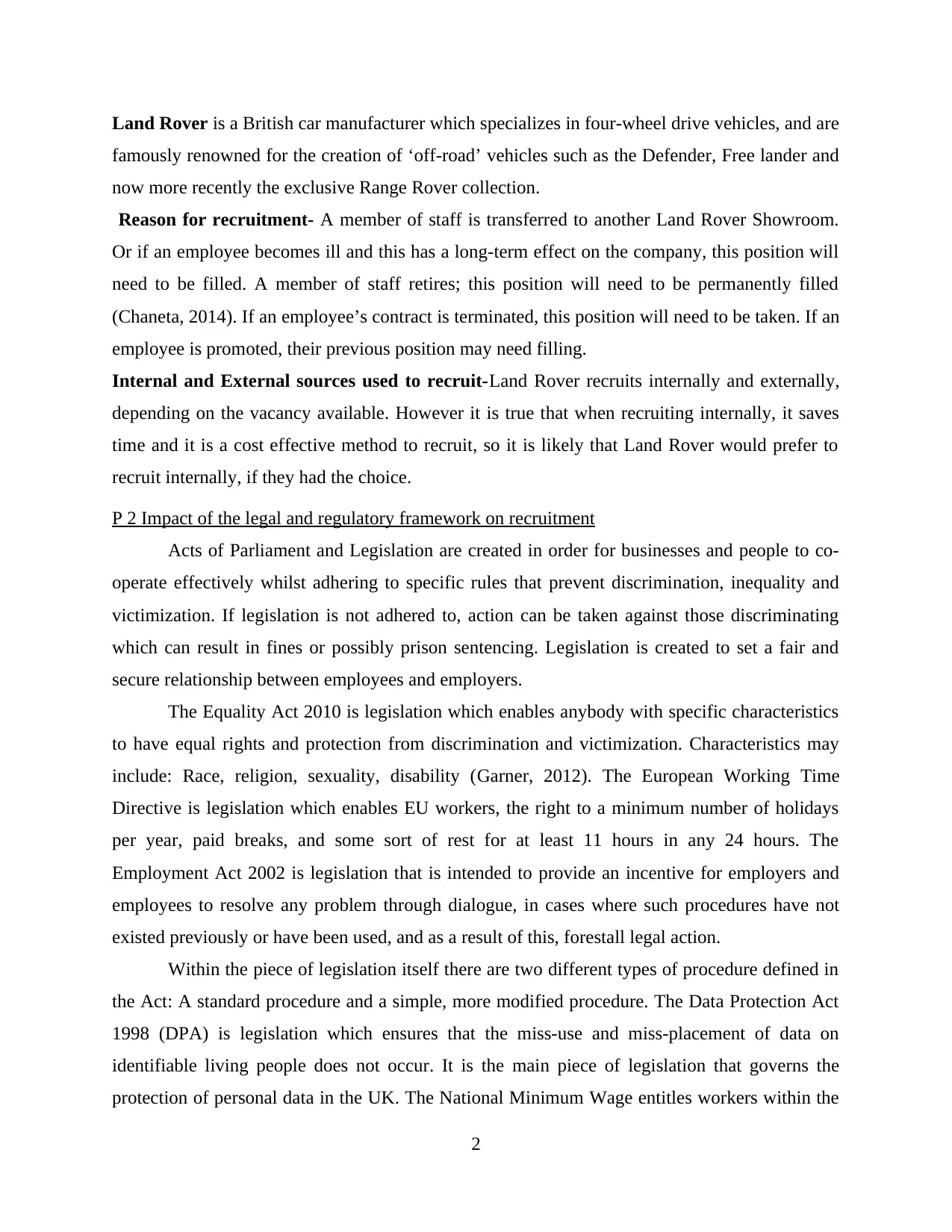
Land Rover is a British car manufacturer which specializes in four-wheel drive vehicles, and are
famously renowned for the creation of ‘off-road’ vehicles such as the Defender, Free lander and
now more recently the exclusive Range Rover collection.
Reason for recruitment- A member of staff is transferred to another Land Rover Showroom.
Or if an employee becomes ill and this has a long-term effect on the company, this position will
need to be filled. A member of staff retires; this position will need to be permanently filled
(Chaneta, 2014). If an employee’s contract is terminated, this position will need to be taken. If an
employee is promoted, their previous position may need filling.
Internal and External sources used to recruit-Land Rover recruits internally and externally,
depending on the vacancy available. However it is true that when recruiting internally, it saves
time and it is a cost effective method to recruit, so it is likely that Land Rover would prefer to
recruit internally, if they had the choice.
P 2 Impact of the legal and regulatory framework on recruitment
Acts of Parliament and Legislation are created in order for businesses and people to co-
operate effectively whilst adhering to specific rules that prevent discrimination, inequality and
victimization. If legislation is not adhered to, action can be taken against those discriminating
which can result in fines or possibly prison sentencing. Legislation is created to set a fair and
secure relationship between employees and employers.
The Equality Act 2010 is legislation which enables anybody with specific characteristics
to have equal rights and protection from discrimination and victimization. Characteristics may
include: Race, religion, sexuality, disability (Garner, 2012). The European Working Time
Directive is legislation which enables EU workers, the right to a minimum number of holidays
per year, paid breaks, and some sort of rest for at least 11 hours in any 24 hours. The
Employment Act 2002 is legislation that is intended to provide an incentive for employers and
employees to resolve any problem through dialogue, in cases where such procedures have not
existed previously or have been used, and as a result of this, forestall legal action.
Within the piece of legislation itself there are two different types of procedure defined in
the Act: A standard procedure and a simple, more modified procedure. The Data Protection Act
1998 (DPA) is legislation which ensures that the miss-use and miss-placement of data on
identifiable living people does not occur. It is the main piece of legislation that governs the
protection of personal data in the UK. The National Minimum Wage entitles workers within the
2
famously renowned for the creation of ‘off-road’ vehicles such as the Defender, Free lander and
now more recently the exclusive Range Rover collection.
Reason for recruitment- A member of staff is transferred to another Land Rover Showroom.
Or if an employee becomes ill and this has a long-term effect on the company, this position will
need to be filled. A member of staff retires; this position will need to be permanently filled
(Chaneta, 2014). If an employee’s contract is terminated, this position will need to be taken. If an
employee is promoted, their previous position may need filling.
Internal and External sources used to recruit-Land Rover recruits internally and externally,
depending on the vacancy available. However it is true that when recruiting internally, it saves
time and it is a cost effective method to recruit, so it is likely that Land Rover would prefer to
recruit internally, if they had the choice.
P 2 Impact of the legal and regulatory framework on recruitment
Acts of Parliament and Legislation are created in order for businesses and people to co-
operate effectively whilst adhering to specific rules that prevent discrimination, inequality and
victimization. If legislation is not adhered to, action can be taken against those discriminating
which can result in fines or possibly prison sentencing. Legislation is created to set a fair and
secure relationship between employees and employers.
The Equality Act 2010 is legislation which enables anybody with specific characteristics
to have equal rights and protection from discrimination and victimization. Characteristics may
include: Race, religion, sexuality, disability (Garner, 2012). The European Working Time
Directive is legislation which enables EU workers, the right to a minimum number of holidays
per year, paid breaks, and some sort of rest for at least 11 hours in any 24 hours. The
Employment Act 2002 is legislation that is intended to provide an incentive for employers and
employees to resolve any problem through dialogue, in cases where such procedures have not
existed previously or have been used, and as a result of this, forestall legal action.
Within the piece of legislation itself there are two different types of procedure defined in
the Act: A standard procedure and a simple, more modified procedure. The Data Protection Act
1998 (DPA) is legislation which ensures that the miss-use and miss-placement of data on
identifiable living people does not occur. It is the main piece of legislation that governs the
protection of personal data in the UK. The National Minimum Wage entitles workers within the
2
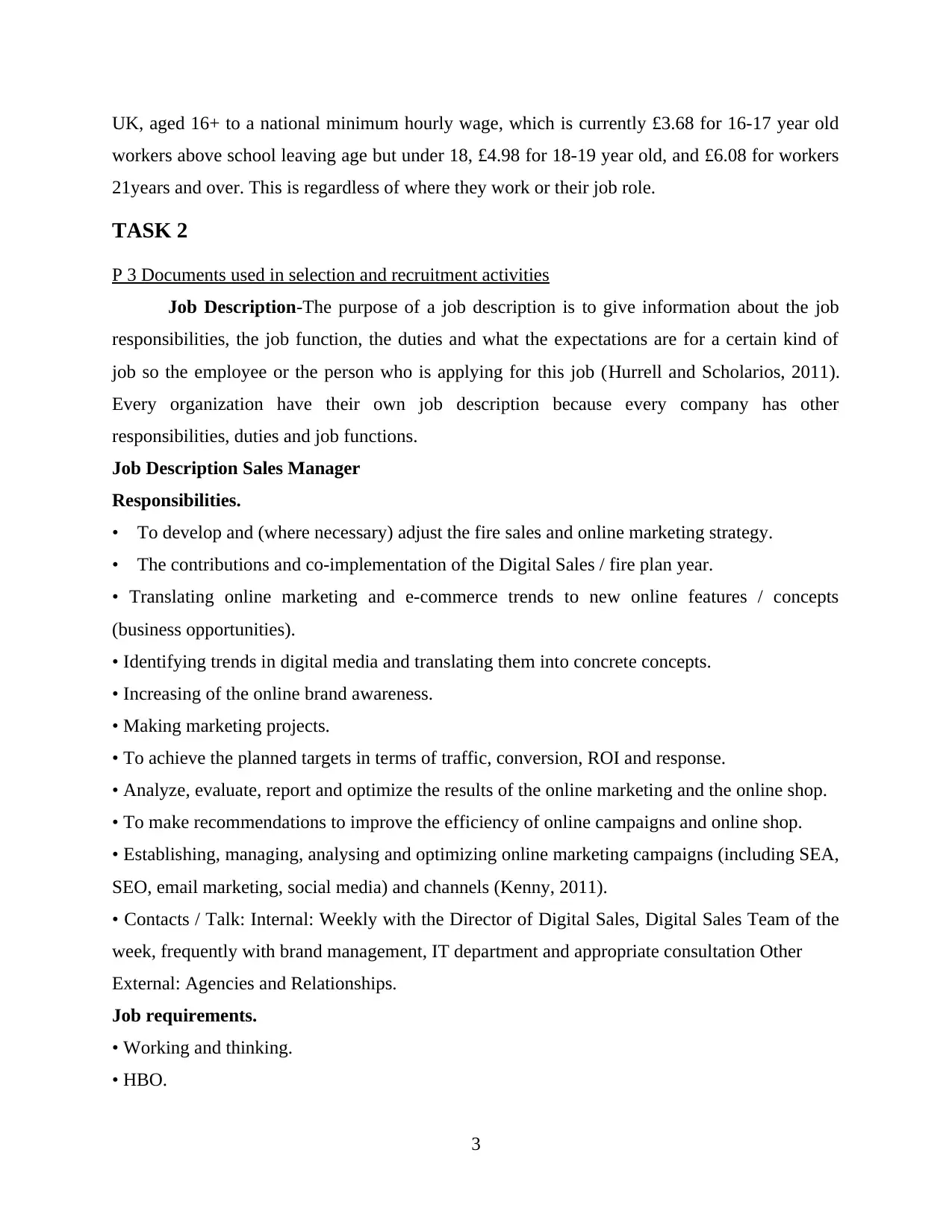
UK, aged 16+ to a national minimum hourly wage, which is currently £3.68 for 16-17 year old
workers above school leaving age but under 18, £4.98 for 18-19 year old, and £6.08 for workers
21years and over. This is regardless of where they work or their job role.
TASK 2
P 3 Documents used in selection and recruitment activities
Job Description-The purpose of a job description is to give information about the job
responsibilities, the job function, the duties and what the expectations are for a certain kind of
job so the employee or the person who is applying for this job (Hurrell and Scholarios, 2011).
Every organization have their own job description because every company has other
responsibilities, duties and job functions.
Job Description Sales Manager
Responsibilities.
• To develop and (where necessary) adjust the fire sales and online marketing strategy.
• The contributions and co-implementation of the Digital Sales / fire plan year.
• Translating online marketing and e-commerce trends to new online features / concepts
(business opportunities).
• Identifying trends in digital media and translating them into concrete concepts.
• Increasing of the online brand awareness.
• Making marketing projects.
• To achieve the planned targets in terms of traffic, conversion, ROI and response.
• Analyze, evaluate, report and optimize the results of the online marketing and the online shop.
• To make recommendations to improve the efficiency of online campaigns and online shop.
• Establishing, managing, analysing and optimizing online marketing campaigns (including SEA,
SEO, email marketing, social media) and channels (Kenny, 2011).
• Contacts / Talk: Internal: Weekly with the Director of Digital Sales, Digital Sales Team of the
week, frequently with brand management, IT department and appropriate consultation Other
External: Agencies and Relationships.
Job requirements.
• Working and thinking.
• HBO.
3
workers above school leaving age but under 18, £4.98 for 18-19 year old, and £6.08 for workers
21years and over. This is regardless of where they work or their job role.
TASK 2
P 3 Documents used in selection and recruitment activities
Job Description-The purpose of a job description is to give information about the job
responsibilities, the job function, the duties and what the expectations are for a certain kind of
job so the employee or the person who is applying for this job (Hurrell and Scholarios, 2011).
Every organization have their own job description because every company has other
responsibilities, duties and job functions.
Job Description Sales Manager
Responsibilities.
• To develop and (where necessary) adjust the fire sales and online marketing strategy.
• The contributions and co-implementation of the Digital Sales / fire plan year.
• Translating online marketing and e-commerce trends to new online features / concepts
(business opportunities).
• Identifying trends in digital media and translating them into concrete concepts.
• Increasing of the online brand awareness.
• Making marketing projects.
• To achieve the planned targets in terms of traffic, conversion, ROI and response.
• Analyze, evaluate, report and optimize the results of the online marketing and the online shop.
• To make recommendations to improve the efficiency of online campaigns and online shop.
• Establishing, managing, analysing and optimizing online marketing campaigns (including SEA,
SEO, email marketing, social media) and channels (Kenny, 2011).
• Contacts / Talk: Internal: Weekly with the Director of Digital Sales, Digital Sales Team of the
week, frequently with brand management, IT department and appropriate consultation Other
External: Agencies and Relationships.
Job requirements.
• Working and thinking.
• HBO.
3
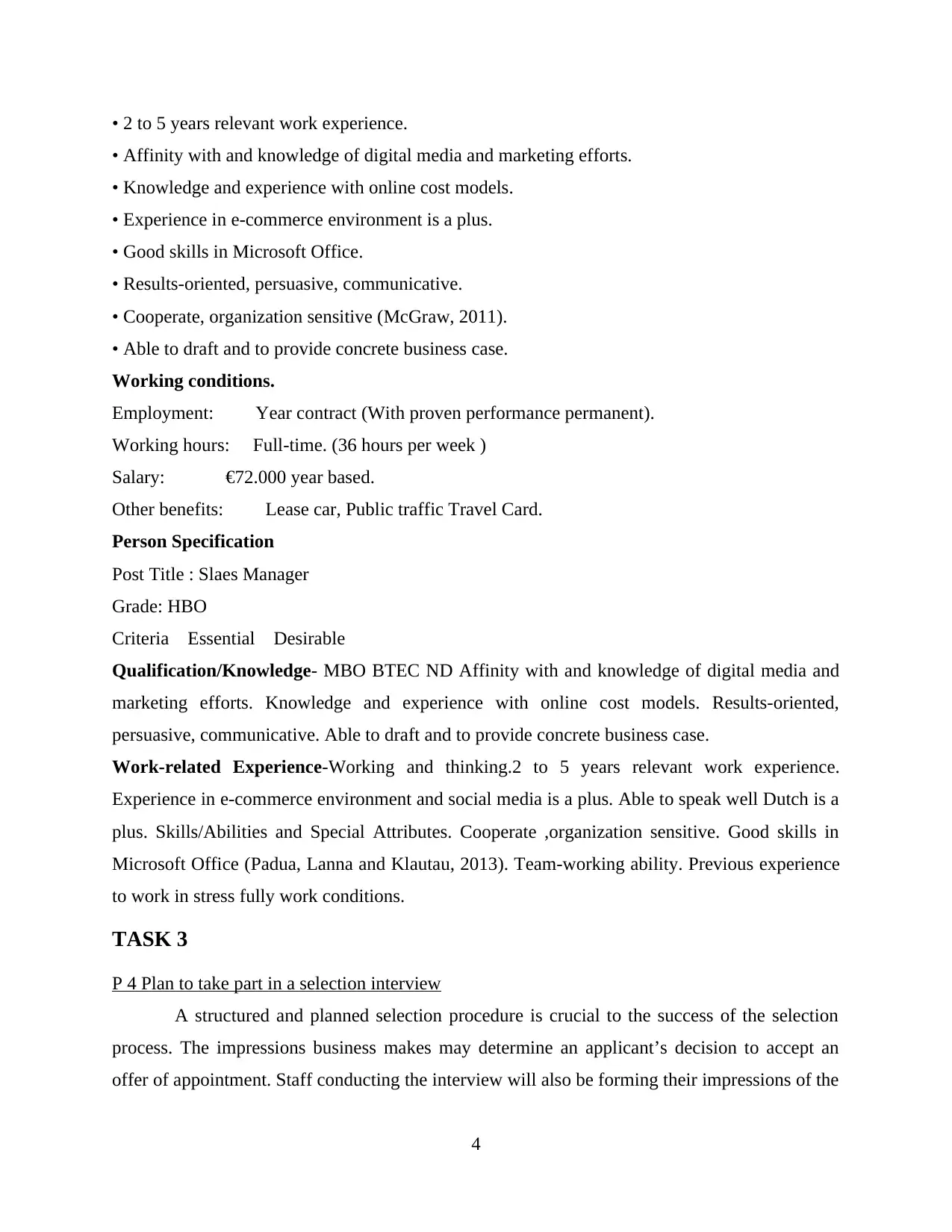
• 2 to 5 years relevant work experience.
• Affinity with and knowledge of digital media and marketing efforts.
• Knowledge and experience with online cost models.
• Experience in e-commerce environment is a plus.
• Good skills in Microsoft Office.
• Results-oriented, persuasive, communicative.
• Cooperate, organization sensitive (McGraw, 2011).
• Able to draft and to provide concrete business case.
Working conditions.
Employment: Year contract (With proven performance permanent).
Working hours: Full-time. (36 hours per week )
Salary: €72.000 year based.
Other benefits: Lease car, Public traffic Travel Card.
Person Specification
Post Title : Slaes Manager
Grade: HBO
Criteria Essential Desirable
Qualification/Knowledge- MBO BTEC ND Affinity with and knowledge of digital media and
marketing efforts. Knowledge and experience with online cost models. Results-oriented,
persuasive, communicative. Able to draft and to provide concrete business case.
Work-related Experience-Working and thinking.2 to 5 years relevant work experience.
Experience in e-commerce environment and social media is a plus. Able to speak well Dutch is a
plus. Skills/Abilities and Special Attributes. Cooperate ,organization sensitive. Good skills in
Microsoft Office (Padua, Lanna and Klautau, 2013). Team-working ability. Previous experience
to work in stress fully work conditions.
TASK 3
P 4 Plan to take part in a selection interview
A structured and planned selection procedure is crucial to the success of the selection
process. The impressions business makes may determine an applicant’s decision to accept an
offer of appointment. Staff conducting the interview will also be forming their impressions of the
4
• Affinity with and knowledge of digital media and marketing efforts.
• Knowledge and experience with online cost models.
• Experience in e-commerce environment is a plus.
• Good skills in Microsoft Office.
• Results-oriented, persuasive, communicative.
• Cooperate, organization sensitive (McGraw, 2011).
• Able to draft and to provide concrete business case.
Working conditions.
Employment: Year contract (With proven performance permanent).
Working hours: Full-time. (36 hours per week )
Salary: €72.000 year based.
Other benefits: Lease car, Public traffic Travel Card.
Person Specification
Post Title : Slaes Manager
Grade: HBO
Criteria Essential Desirable
Qualification/Knowledge- MBO BTEC ND Affinity with and knowledge of digital media and
marketing efforts. Knowledge and experience with online cost models. Results-oriented,
persuasive, communicative. Able to draft and to provide concrete business case.
Work-related Experience-Working and thinking.2 to 5 years relevant work experience.
Experience in e-commerce environment and social media is a plus. Able to speak well Dutch is a
plus. Skills/Abilities and Special Attributes. Cooperate ,organization sensitive. Good skills in
Microsoft Office (Padua, Lanna and Klautau, 2013). Team-working ability. Previous experience
to work in stress fully work conditions.
TASK 3
P 4 Plan to take part in a selection interview
A structured and planned selection procedure is crucial to the success of the selection
process. The impressions business makes may determine an applicant’s decision to accept an
offer of appointment. Staff conducting the interview will also be forming their impressions of the
4
Paraphrase This Document
Need a fresh take? Get an instant paraphrase of this document with our AI Paraphraser
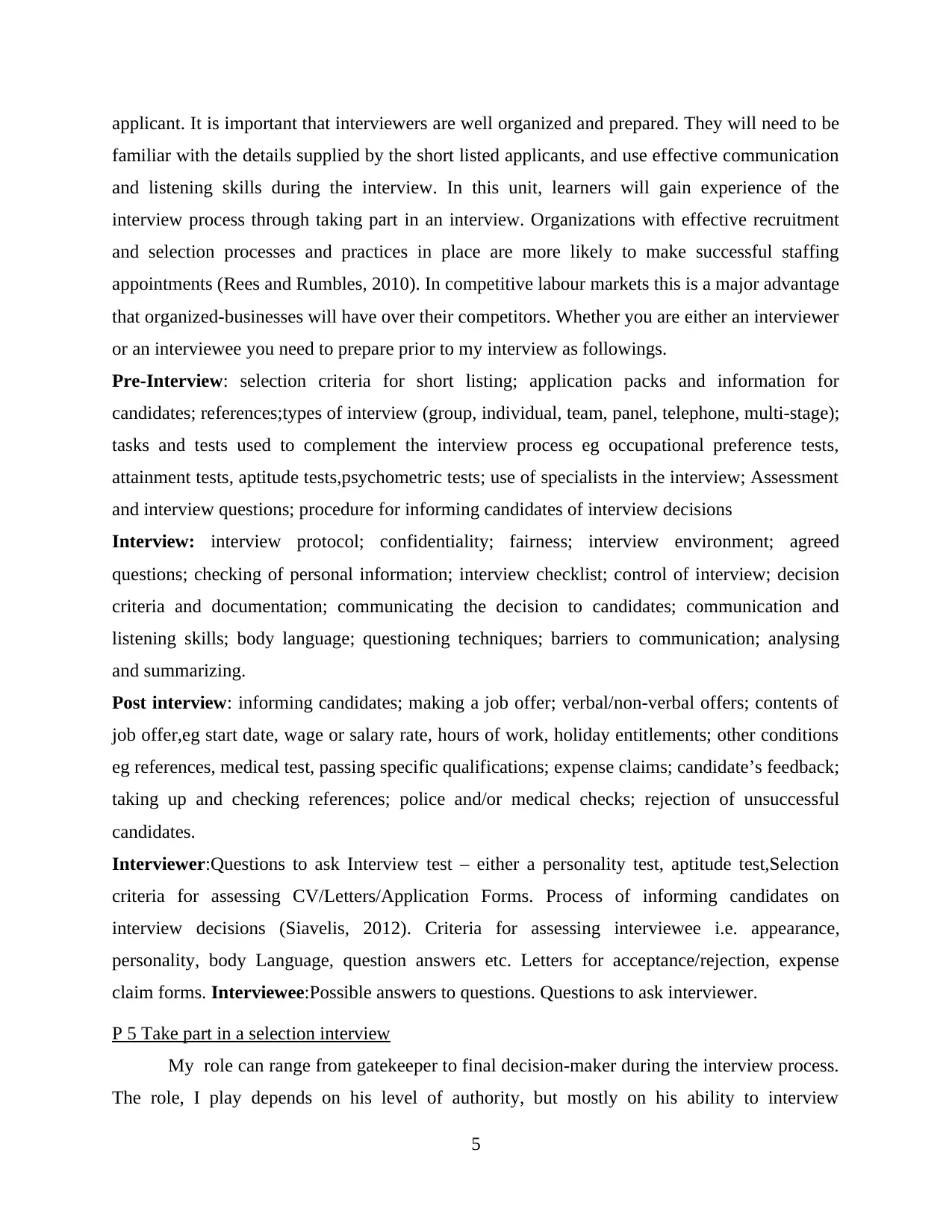
applicant. It is important that interviewers are well organized and prepared. They will need to be
familiar with the details supplied by the short listed applicants, and use effective communication
and listening skills during the interview. In this unit, learners will gain experience of the
interview process through taking part in an interview. Organizations with effective recruitment
and selection processes and practices in place are more likely to make successful staffing
appointments (Rees and Rumbles, 2010). In competitive labour markets this is a major advantage
that organized-businesses will have over their competitors. Whether you are either an interviewer
or an interviewee you need to prepare prior to my interview as followings.
Pre-Interview: selection criteria for short listing; application packs and information for
candidates; references;types of interview (group, individual, team, panel, telephone, multi-stage);
tasks and tests used to complement the interview process eg occupational preference tests,
attainment tests, aptitude tests,psychometric tests; use of specialists in the interview; Assessment
and interview questions; procedure for informing candidates of interview decisions
Interview: interview protocol; confidentiality; fairness; interview environment; agreed
questions; checking of personal information; interview checklist; control of interview; decision
criteria and documentation; communicating the decision to candidates; communication and
listening skills; body language; questioning techniques; barriers to communication; analysing
and summarizing.
Post interview: informing candidates; making a job offer; verbal/non-verbal offers; contents of
job offer,eg start date, wage or salary rate, hours of work, holiday entitlements; other conditions
eg references, medical test, passing specific qualifications; expense claims; candidate’s feedback;
taking up and checking references; police and/or medical checks; rejection of unsuccessful
candidates.
Interviewer:Questions to ask Interview test – either a personality test, aptitude test,Selection
criteria for assessing CV/Letters/Application Forms. Process of informing candidates on
interview decisions (Siavelis, 2012). Criteria for assessing interviewee i.e. appearance,
personality, body Language, question answers etc. Letters for acceptance/rejection, expense
claim forms. Interviewee:Possible answers to questions. Questions to ask interviewer.
P 5 Take part in a selection interview
My role can range from gatekeeper to final decision-maker during the interview process.
The role, I play depends on his level of authority, but mostly on his ability to interview
5
familiar with the details supplied by the short listed applicants, and use effective communication
and listening skills during the interview. In this unit, learners will gain experience of the
interview process through taking part in an interview. Organizations with effective recruitment
and selection processes and practices in place are more likely to make successful staffing
appointments (Rees and Rumbles, 2010). In competitive labour markets this is a major advantage
that organized-businesses will have over their competitors. Whether you are either an interviewer
or an interviewee you need to prepare prior to my interview as followings.
Pre-Interview: selection criteria for short listing; application packs and information for
candidates; references;types of interview (group, individual, team, panel, telephone, multi-stage);
tasks and tests used to complement the interview process eg occupational preference tests,
attainment tests, aptitude tests,psychometric tests; use of specialists in the interview; Assessment
and interview questions; procedure for informing candidates of interview decisions
Interview: interview protocol; confidentiality; fairness; interview environment; agreed
questions; checking of personal information; interview checklist; control of interview; decision
criteria and documentation; communicating the decision to candidates; communication and
listening skills; body language; questioning techniques; barriers to communication; analysing
and summarizing.
Post interview: informing candidates; making a job offer; verbal/non-verbal offers; contents of
job offer,eg start date, wage or salary rate, hours of work, holiday entitlements; other conditions
eg references, medical test, passing specific qualifications; expense claims; candidate’s feedback;
taking up and checking references; police and/or medical checks; rejection of unsuccessful
candidates.
Interviewer:Questions to ask Interview test – either a personality test, aptitude test,Selection
criteria for assessing CV/Letters/Application Forms. Process of informing candidates on
interview decisions (Siavelis, 2012). Criteria for assessing interviewee i.e. appearance,
personality, body Language, question answers etc. Letters for acceptance/rejection, expense
claim forms. Interviewee:Possible answers to questions. Questions to ask interviewer.
P 5 Take part in a selection interview
My role can range from gatekeeper to final decision-maker during the interview process.
The role, I play depends on his level of authority, but mostly on his ability to interview
5
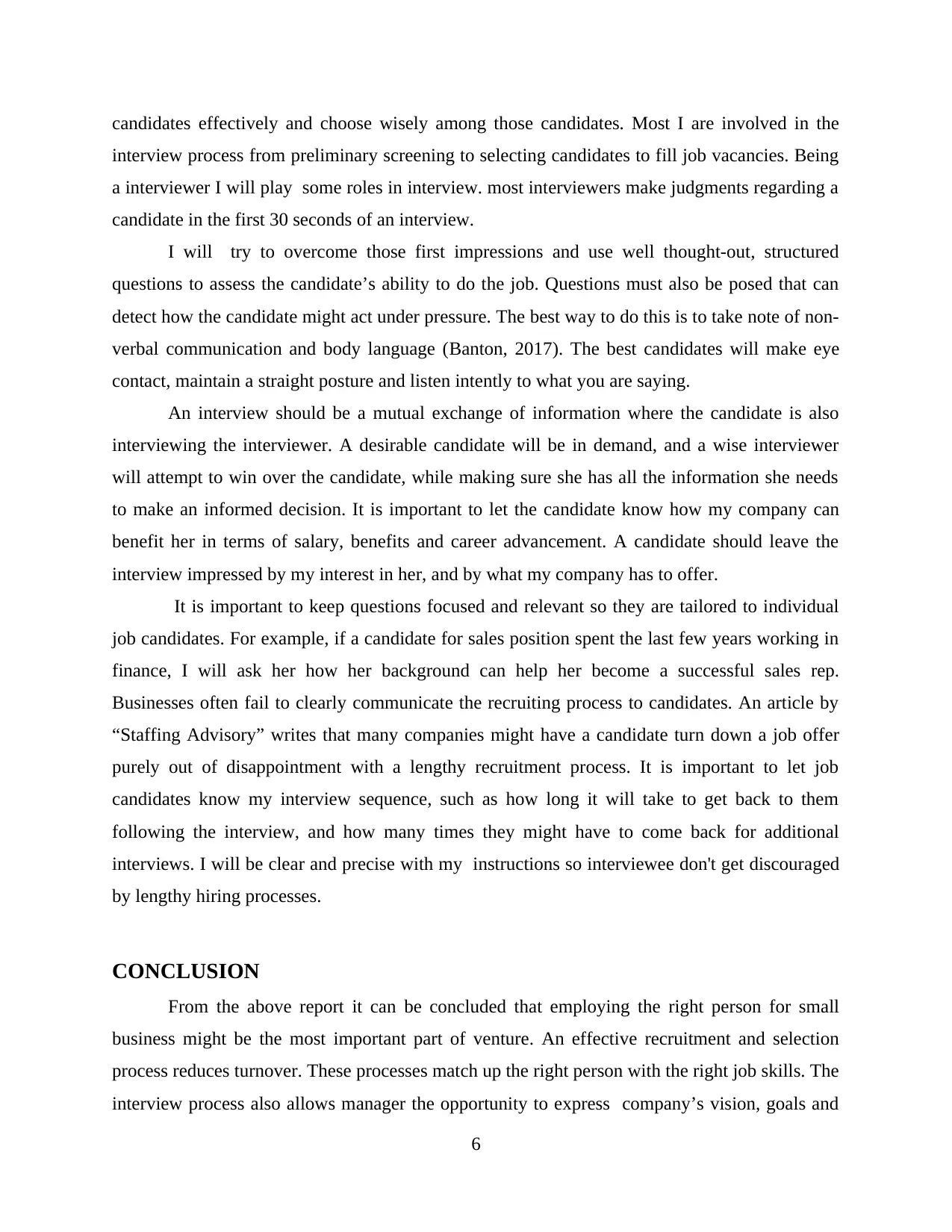
candidates effectively and choose wisely among those candidates. Most I are involved in the
interview process from preliminary screening to selecting candidates to fill job vacancies. Being
a interviewer I will play some roles in interview. most interviewers make judgments regarding a
candidate in the first 30 seconds of an interview.
I will try to overcome those first impressions and use well thought-out, structured
questions to assess the candidate’s ability to do the job. Questions must also be posed that can
detect how the candidate might act under pressure. The best way to do this is to take note of non-
verbal communication and body language (Banton, 2017). The best candidates will make eye
contact, maintain a straight posture and listen intently to what you are saying.
An interview should be a mutual exchange of information where the candidate is also
interviewing the interviewer. A desirable candidate will be in demand, and a wise interviewer
will attempt to win over the candidate, while making sure she has all the information she needs
to make an informed decision. It is important to let the candidate know how my company can
benefit her in terms of salary, benefits and career advancement. A candidate should leave the
interview impressed by my interest in her, and by what my company has to offer.
It is important to keep questions focused and relevant so they are tailored to individual
job candidates. For example, if a candidate for sales position spent the last few years working in
finance, I will ask her how her background can help her become a successful sales rep.
Businesses often fail to clearly communicate the recruiting process to candidates. An article by
“Staffing Advisory” writes that many companies might have a candidate turn down a job offer
purely out of disappointment with a lengthy recruitment process. It is important to let job
candidates know my interview sequence, such as how long it will take to get back to them
following the interview, and how many times they might have to come back for additional
interviews. I will be clear and precise with my instructions so interviewee don't get discouraged
by lengthy hiring processes.
CONCLUSION
From the above report it can be concluded that employing the right person for small
business might be the most important part of venture. An effective recruitment and selection
process reduces turnover. These processes match up the right person with the right job skills. The
interview process also allows manager the opportunity to express company’s vision, goals and
6
interview process from preliminary screening to selecting candidates to fill job vacancies. Being
a interviewer I will play some roles in interview. most interviewers make judgments regarding a
candidate in the first 30 seconds of an interview.
I will try to overcome those first impressions and use well thought-out, structured
questions to assess the candidate’s ability to do the job. Questions must also be posed that can
detect how the candidate might act under pressure. The best way to do this is to take note of non-
verbal communication and body language (Banton, 2017). The best candidates will make eye
contact, maintain a straight posture and listen intently to what you are saying.
An interview should be a mutual exchange of information where the candidate is also
interviewing the interviewer. A desirable candidate will be in demand, and a wise interviewer
will attempt to win over the candidate, while making sure she has all the information she needs
to make an informed decision. It is important to let the candidate know how my company can
benefit her in terms of salary, benefits and career advancement. A candidate should leave the
interview impressed by my interest in her, and by what my company has to offer.
It is important to keep questions focused and relevant so they are tailored to individual
job candidates. For example, if a candidate for sales position spent the last few years working in
finance, I will ask her how her background can help her become a successful sales rep.
Businesses often fail to clearly communicate the recruiting process to candidates. An article by
“Staffing Advisory” writes that many companies might have a candidate turn down a job offer
purely out of disappointment with a lengthy recruitment process. It is important to let job
candidates know my interview sequence, such as how long it will take to get back to them
following the interview, and how many times they might have to come back for additional
interviews. I will be clear and precise with my instructions so interviewee don't get discouraged
by lengthy hiring processes.
CONCLUSION
From the above report it can be concluded that employing the right person for small
business might be the most important part of venture. An effective recruitment and selection
process reduces turnover. These processes match up the right person with the right job skills. The
interview process also allows manager the opportunity to express company’s vision, goals and
6
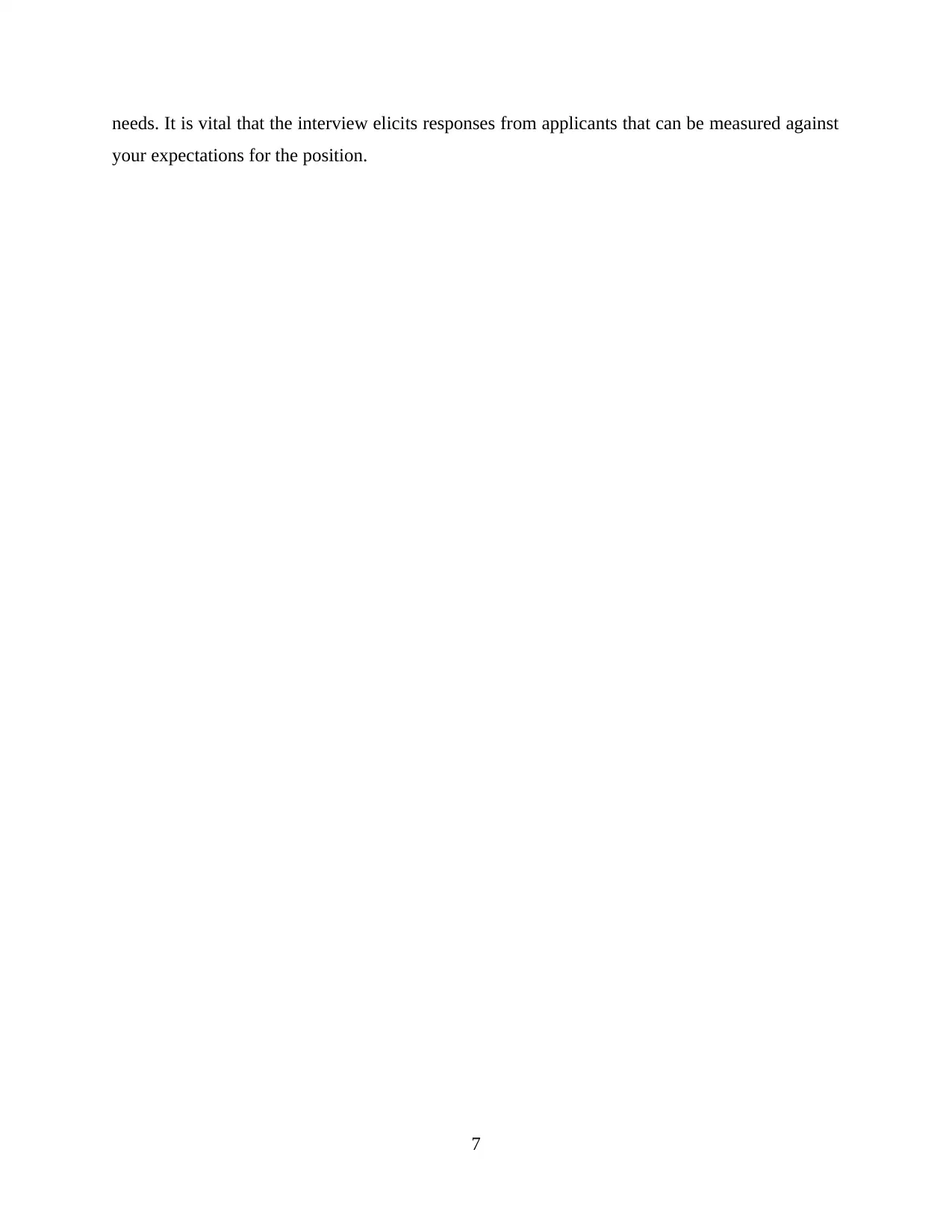
needs. It is vital that the interview elicits responses from applicants that can be measured against
your expectations for the position.
7
your expectations for the position.
7
Secure Best Marks with AI Grader
Need help grading? Try our AI Grader for instant feedback on your assignments.
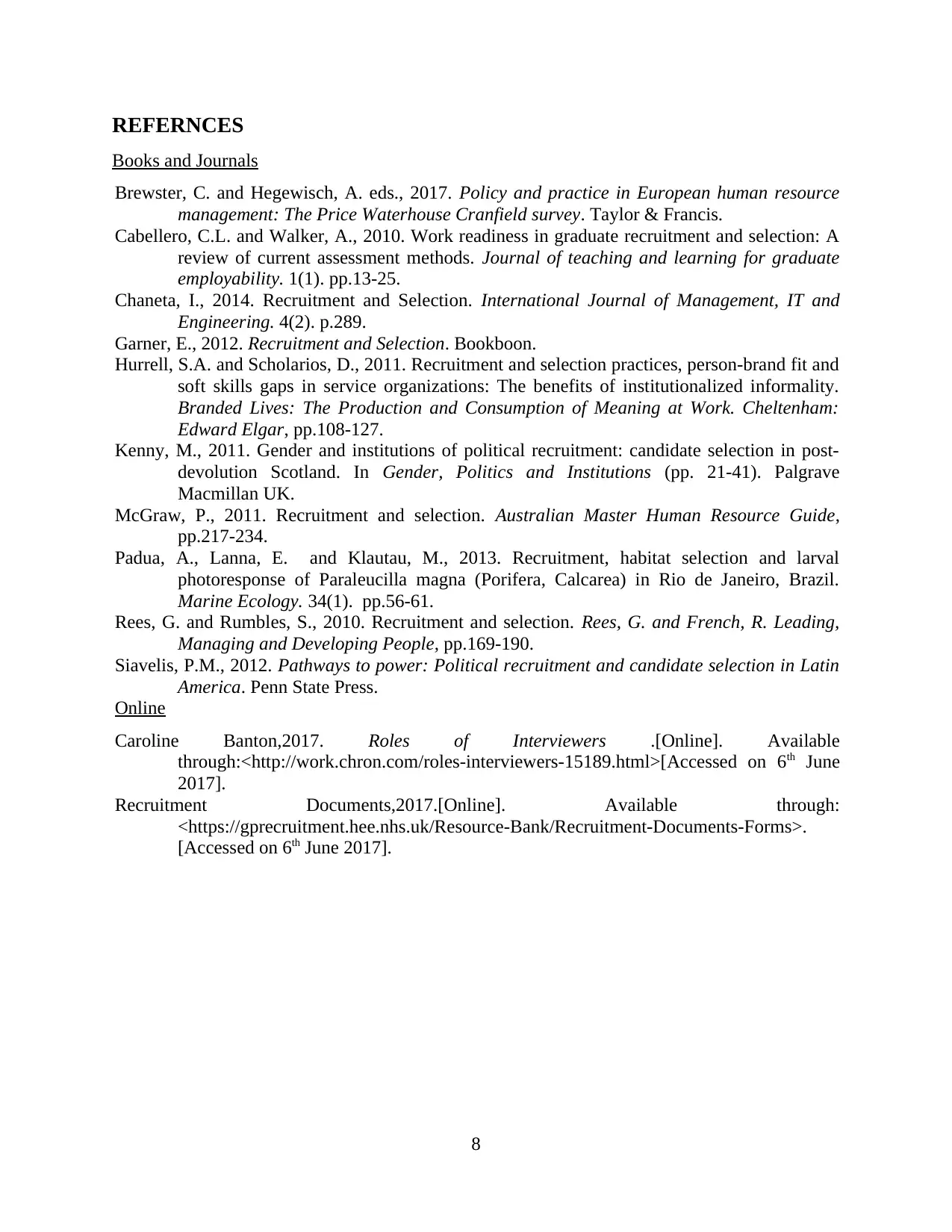
REFERNCES
Books and Journals
Brewster, C. and Hegewisch, A. eds., 2017. Policy and practice in European human resource
management: The Price Waterhouse Cranfield survey. Taylor & Francis.
Cabellero, C.L. and Walker, A., 2010. Work readiness in graduate recruitment and selection: A
review of current assessment methods. Journal of teaching and learning for graduate
employability. 1(1). pp.13-25.
Chaneta, I., 2014. Recruitment and Selection. International Journal of Management, IT and
Engineering. 4(2). p.289.
Garner, E., 2012. Recruitment and Selection. Bookboon.
Hurrell, S.A. and Scholarios, D., 2011. Recruitment and selection practices, person-brand fit and
soft skills gaps in service organizations: The benefits of institutionalized informality.
Branded Lives: The Production and Consumption of Meaning at Work. Cheltenham:
Edward Elgar, pp.108-127.
Kenny, M., 2011. Gender and institutions of political recruitment: candidate selection in post-
devolution Scotland. In Gender, Politics and Institutions (pp. 21-41). Palgrave
Macmillan UK.
McGraw, P., 2011. Recruitment and selection. Australian Master Human Resource Guide,
pp.217-234.
Padua, A., Lanna, E. and Klautau, M., 2013. Recruitment, habitat selection and larval
photoresponse of Paraleucilla magna (Porifera, Calcarea) in Rio de Janeiro, Brazil.
Marine Ecology. 34(1). pp.56-61.
Rees, G. and Rumbles, S., 2010. Recruitment and selection. Rees, G. and French, R. Leading,
Managing and Developing People, pp.169-190.
Siavelis, P.M., 2012. Pathways to power: Political recruitment and candidate selection in Latin
America. Penn State Press.
Online
Caroline Banton,2017. Roles of Interviewers .[Online]. Available
through:<http://work.chron.com/roles-interviewers-15189.html>[Accessed on 6th June
2017].
Recruitment Documents,2017.[Online]. Available through:
<https://gprecruitment.hee.nhs.uk/Resource-Bank/Recruitment-Documents-Forms>.
[Accessed on 6th June 2017].
8
Books and Journals
Brewster, C. and Hegewisch, A. eds., 2017. Policy and practice in European human resource
management: The Price Waterhouse Cranfield survey. Taylor & Francis.
Cabellero, C.L. and Walker, A., 2010. Work readiness in graduate recruitment and selection: A
review of current assessment methods. Journal of teaching and learning for graduate
employability. 1(1). pp.13-25.
Chaneta, I., 2014. Recruitment and Selection. International Journal of Management, IT and
Engineering. 4(2). p.289.
Garner, E., 2012. Recruitment and Selection. Bookboon.
Hurrell, S.A. and Scholarios, D., 2011. Recruitment and selection practices, person-brand fit and
soft skills gaps in service organizations: The benefits of institutionalized informality.
Branded Lives: The Production and Consumption of Meaning at Work. Cheltenham:
Edward Elgar, pp.108-127.
Kenny, M., 2011. Gender and institutions of political recruitment: candidate selection in post-
devolution Scotland. In Gender, Politics and Institutions (pp. 21-41). Palgrave
Macmillan UK.
McGraw, P., 2011. Recruitment and selection. Australian Master Human Resource Guide,
pp.217-234.
Padua, A., Lanna, E. and Klautau, M., 2013. Recruitment, habitat selection and larval
photoresponse of Paraleucilla magna (Porifera, Calcarea) in Rio de Janeiro, Brazil.
Marine Ecology. 34(1). pp.56-61.
Rees, G. and Rumbles, S., 2010. Recruitment and selection. Rees, G. and French, R. Leading,
Managing and Developing People, pp.169-190.
Siavelis, P.M., 2012. Pathways to power: Political recruitment and candidate selection in Latin
America. Penn State Press.
Online
Caroline Banton,2017. Roles of Interviewers .[Online]. Available
through:<http://work.chron.com/roles-interviewers-15189.html>[Accessed on 6th June
2017].
Recruitment Documents,2017.[Online]. Available through:
<https://gprecruitment.hee.nhs.uk/Resource-Bank/Recruitment-Documents-Forms>.
[Accessed on 6th June 2017].
8
1 out of 11
Related Documents
Your All-in-One AI-Powered Toolkit for Academic Success.
+13062052269
info@desklib.com
Available 24*7 on WhatsApp / Email
![[object Object]](/_next/static/media/star-bottom.7253800d.svg)
Unlock your academic potential
© 2024 | Zucol Services PVT LTD | All rights reserved.





